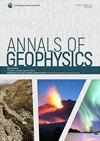WWLLN数据用于模拟雷暴产生的全球电离层电场
IF 1.2
4区 地球科学
Q3 GEOCHEMISTRY & GEOPHYSICS
引用次数: 0
摘要
在大气全球电路中流动的电流被电离层电流关闭。物理和数学方法模拟电离层电位驱动这些电流已经描述在我们以前的论文。只研究雷暴产生的内部电场和电流,没有任何磁层电流源或发电机。大气电导率随海拔的变化曲线是经验确定的,并考虑了地球表面的地形。电离层导体的二维近似是基于沿地磁场的高导电性;使用经验模型计算Pedersen和Hall电导率。电离层E层和f层的电势沿每条磁力线被认为是恒定的。与以前版本的模式相比,主要的进步是通过应用地面世界闪电定位网络获得的雷暴全球分布而获得的。在2008年7月太阳活动低的典型条件下,在UTC时间18:00,计算得到电离层最大电位差为54 V。这个最新版本的模型包含赤道电喷流。白天存在强度高达65 A的电喷流,夜间存在强度高达40 A的电喷流,在我们的模型中,为了满足卡内基曲线,即地面垂直电场随UTC的日变化,我们取GEC中流过的总电流为1.43 kA。在新模式中,电势的最大值从非洲转移到东南亚。赤道电喷流也会改变它们的位置、方向和强度。本文章由计算机程序翻译,如有差异,请以英文原文为准。
WWLLN Data Used to Model the Global Ionospheric Electric Field Generated by Thunderstorms
Electric currents flowing in the atmospheric global electric circuit (GEC) are closed by ionospheric currents. The physical and mathematical approach to simulate the ionospheric potential which drives these currents has been described in our previous papers. Only the internal electric fields and currents generated by thunderstorms are studied, and without any magnetospheric current sources or generators. The atmospheric conductivity profiles with altitude are empirically determined, and the topography of the Earth’s surface is taken into account. A two-dimensional approximation of the ionospheric conductor is based on the high conductivity along the geomagnetic field; the Pedersen and Hall conductivities are calculated using empirical models. The potentials in the E- and F-layers of the ionosphere are considered to be constant along each magnetic field line. The main progress in comparison with previous versions of the model is obtained through applying the global distribution of thunderstorms obtained from the ground-based World Wide Lightning Location Network. Under typical conditions for July, under low solar activity in 2008, at 18:00 UTC, the calculated maximum potential difference in the ionosphere is 54 V. This newest version of our model contains the equatorial electrojets. There are day-time electrojets, the strengths of which are up to 65 A, and night-time ones (of up to 40 A), while the total current flowing in the GEC is taken to be equal to 1.43 kA in our model to satisfy the Carnegie curve, i.e. the diurnal variation of the vertical electric field at ground level with UTC. The maximum of the electric potential is shifted from Africa to South-East Asia in the new model. The equatorial electrojets also change their position, direction and intensity.
求助全文
通过发布文献求助,成功后即可免费获取论文全文。
去求助
来源期刊

Annals of Geophysics
地学-地球化学与地球物理
CiteScore
2.40
自引率
0.00%
发文量
38
审稿时长
4-8 weeks
期刊介绍:
Annals of Geophysics is an international, peer-reviewed, open-access, online journal. Annals of Geophysics welcomes contributions on primary research on Seismology, Geodesy, Volcanology, Physics and Chemistry of the Earth, Oceanography and Climatology, Geomagnetism and Paleomagnetism, Geodynamics and Tectonophysics, Physics and Chemistry of the Atmosphere.
It provides:
-Open-access, freely accessible online (authors retain copyright)
-Fast publication times
-Peer review by expert, practicing researchers
-Free of charge publication
-Post-publication tools to indicate quality and impact
-Worldwide media coverage.
Annals of Geophysics is published by Istituto Nazionale di Geofisica e Vulcanologia (INGV), nonprofit public research institution.
 求助内容:
求助内容: 应助结果提醒方式:
应助结果提醒方式:


